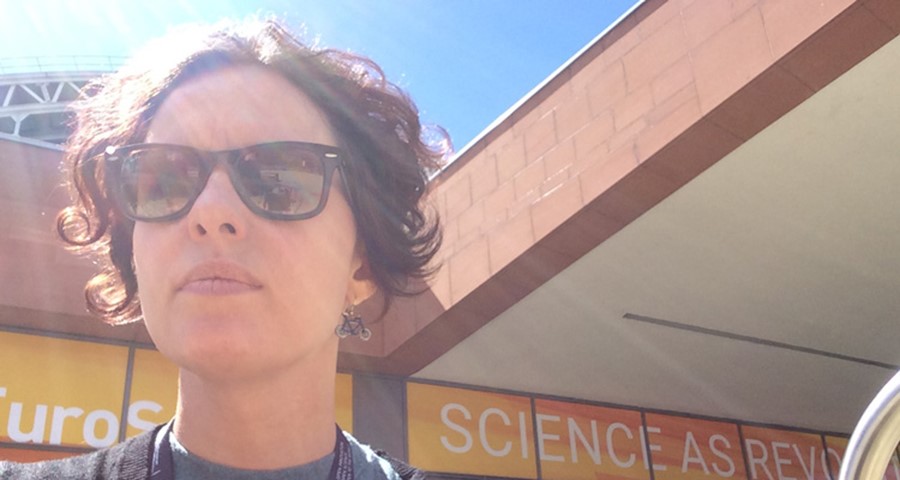Young reserchers supported to visit ESOF
Teresa Gatti from the University of Padova, Italy was one of nine young researchers who got financial support to visit ESOF in Manchester earlier this summer.

Teresa Gatti at ESOF.
Funding support from the European Science Foundation (ESF) and the Graphene Flagship in collaboration with EuroScience enabled nine young researchers working on graphene and related materials to attend the EuroScience Open Forum (ESOF) which took place in Manchester at the end of July. The successful applicants were from eight European countries. Their attendance at ESOF also included a visit to the National Graphene Institute which is based in Manchester and is one of the world’s leading facilities for graphene research.
One of the researchers who received the grant was the nanotoxicology and nanomedicine postdoc, Dr Barbara Drasler from University of Fribourg in Switzerland;
“I found the sections covering scientific career planning and some of the pure material science and biological presentations very useful. The sessions tailored for early stage researchers were particularity useful as I will soon be applying for my first grant funding. Throughout the exhibition, I was communicating with both the experts in the field of graphene-related materials research and with representatives of a broader scientific community, the first experience of this kind in my career. The workshop on Nanomaterials and Medicine encouraged me to think “out-of-the-box” and led to a very interesting discussion amongst the group.
It was a great honor and privilege for me to participate in the guided tour of the National Graphene Institute. It offered me an insight into state-of-the-art graphene materials production and synthesis. As I am engaged in more of the toxicological aspect of graphene materials, the visit itself also provided me with the opportunity to share my knowledge and experience with peer-scientists working on the material aspect of graphene science. Established collaborations might lead to future joint work in the scope of graphene-related research.”
Dr Teresa Gatti from the University of Padova, Italy, who is a currently working on a nanotechnology postdoc, also received a travel grant to attend ESOF. She talked about how ESOF helped to create new understanding of her topic;
“The discussion about science and art included in the Science in our Cultures session was quite stimulating and provided me with key new interpretation of knowledge, intended in a more general, humanistic view.
As for keynotes, the most impressive I attended was the John Lloyd interview of Sir Andre Geim, Physics Nobel Laureate. The interview shed light on Geim’s personal experience and thoughts and he had some acute observations about education in physics and in science in general. Helped by the big sense of humour of both the interviewer and the interviewee, the atmosphere was kept continuously high by referring to many anecdotal episodes of Geim’s education, in Russia and then his scientific career, in The Netherlands and in the UK. Much time was dedicated to hilarious topics, such as the Geim’s winning of both Nobel and Ig-Nobel prices, being the only person in the world to get both the titles.
The visit to the National Graphene Institute and excellent tour given by the NGI director Vladimir Falko, gave all of us grantees the possibility to see the very modern laboratories and hear about research activities carried out therein. This was really a great chance for us to get in touch with cutting edge technologies and scientific excellence concerning the topics on which we currently work.”
ESF is a partner of the Graphene Flagship Consortium’s Core 1 project (under H2020 phase) in charge of the work package focused on European alignment and international collaboration. ESF is a services-based organisation that contributes to the European Research Area (ERA).
Dr Jean-Claude Worms, Chief Executive of the ESF, said; “ESOF is a highly significant event in the European science calendar. In particular it offers young researchers valuable networking opportunities at this critical, early stage of their career. Supporting collaboration is a key part of ESF’s role and we are delighted to have been able, along with the Graphene Flagship, to facilitate this trip.”
Professor Jari Kinaret, Director of the Graphene Flagship, said; “Young researchers are both the present and future of the Graphene Flagship. Graduate students and postdoctoral researchers do the bulk of the work in academic laboratories and are at the cutting edge of developments in this area. After finishing their education and training, they have an important role to play in sharing insight on graphene and related materials with various industries. They can also create greater awareness and understanding of the flagship and its work with a wider audience.”
Young researchers are both the present and future of the Graphene Flagship. They can also create greater awareness and understanding of the flagship and its work with a wider audience.”
Flagship Director



